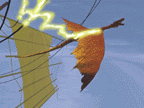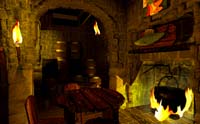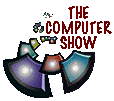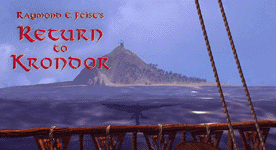HOME
By Al Giovetti
Price: $50
Genre: fantasy role playing adventure
Release: December 1998(was December 1996)
Developer: PyroTechnix (inherited from 7th level)
Lead Technical Artist: Jeff Mills
Programmer:
Lead Game Author:Brian Kraack
True 3D Development:Dave Mushaben
3D Studio MAX Filters:Brian Jantzen
Object Oriented Archetecture:Chuck Wiggins
Music Composer: Chuck Mitchell
Licensee: Raymond Feist
Producer: Sinjin Bain
Publisher: Sierra On-Line(inherited from 7th level)
Phone: 800-757-7707
Website:
www.sierra.com
Walkthrough: Read the Return to Krondor Walkthrough
Cheats: Read the Return to Krondor Cheats
Requirements:Windows 95, DirectDraw, DirectSound, Direct3D



Return to Krondor
History
Raymond E. Feist was born in Southern California and still resides in San Diego. Raymond Feist has written five works on the worlds of Midkemia. Betrayal at Krondor was set during the riftwars which were wars between different fantasy worlds joined by rifts in space and time.
The rifts allowed peoples of each world to slip through and travel in space and time. Some travelers guarded the access to the rifts to take advantage of the adventure of visiting other times and places. Merchants used the rifts to trade new and exotic goods and amass fortunes. And rulers, both evil and benign, used the rifts for conquest, plunder, and alliances, but mostly to do what leaders do, amass more power and wealth.
Ray signed the agreement with 7th level to produce the sequel, now known as Return to Krondor, on November 15, 1994 in Las Vegas, Nevada. The game has progressed from there with many watching the developments in a newsletter called the Monthly Midkemian and other sources which occupy the web. When many Return to Krondor and Midkemia in the sequel game, they will not recognize the location since the new game will use all new graphics which go beyond the 1993 Betrayal at Krondor (BAK) graphics and interface.
When 7th level went belly up just about December of 1996, Sierra gave the product over to PyroTechnix in Cincinnati, Ohio. Sinjin Bain, the founder and part-time gamer, at PyroTechnix inherited the product.
Ray Feist has also been involved. Ray talked to Sinjin at least two times a week. Ray and this author used to talk regularly about the original Betrayal at Krondor, which was the first Krondor game also produced by Sierra. Ray typically provides creative concepts during the production of the product and is probably the most intensively interested licensee on the planet. The attention to detail shows in the final product. Sinjin Bain commented, "Raymond and I spoke several times a week. We're both creative people and we tossed around a lot of ideas. I felt we had many creative exchanges. Ray's open mind to new approaches really helped us. We compared notes and he offered a lot of great input."
Company Line
This truely compelling story takes playrs from the dizzying heights of Krondor's Palace to the haunting depths of a temple dedicated to an evil as ancient as the gods themselves. Guide a party of five heroes through 11 chapters of adventure and intrigue, racing against Bear, an evil madman, to recover the Tear of the Gods, the Ishapian Church's most sacred relic that possesses unimaginable power. Old friends like Squire James return in this latest adventure, while players can look forward to a whole new cast of mystical characters like the Keshian sorceress Jazhara, who will aid them in their quest.
Never before has an RPG given you so much of what you want. A complex an mystical story from best-selling fantasy author Raymond E. Feist, intense, high-quality graphics, seemless transition from navigation to combat, a myriad of spells and alchemy, plus rich characters, turn-based warfare and nasty creatures. Return to Krondor delivers it all.
Return to Krondor, the spectacular RPG, set in Raymond E. Feist's world of Midkemia, will take hard-core RPG adventure gaming to new heights. Hundreds of thousands of devoted fans who made Betrayal at Krondor one of the best selling RPGs of all time, are impatiently awaiting the release of this title.
Return to Krondor envelopes you in a world of strange creatures, desperate characters and the magic arts, Re-enter the complex and compelling kingdom of Midkemia in this sequel to the best selling RPG Betrayal at Krondor.
The Tear of the Gods, a holy artifact possessing unimaginable power, is in peril. Your party must race against Bear, an evil madman, and his followers to raise the sunken ship that hold the artifact and return it to its rightful place in the Temple of the Gods. The fate of Krondor is in your hands.
Begin your journey through 11 chapters of intrigue and adventure from the mind of one of America's best-loved fantasy novelists. Over 30 varieties of locks, traps and puzzles.
Game Play
Sinjin Bain, the President of Pyro Technix which is the company that developed Return to Krondor for Sierra Studios, said this about the game: "What we think makes it so unique and wonderful to play is that gamers get the hardcore turn-based combat and alchemy systems, beautiful graphics, an accessible user interface, animation, music, dialog and sound with Raymond Feist's great story wrapped around it. Our goal is to give gamers an RPG full of adventure.
Combat: According to our unnamed source, "The combat system bears some superficial resemblance to the system used in BAK since both are 3rd person, turn-based. However, the tactical options have been enhanced dramatically allowing characters to choose from three differing attack styles, three types of defense, and over 60 spells. Critical strikes, parting attacks and magic potions are all supported. Combat also features a unique fate system that adds drama and an individuality to each battle. There is no grid or hex map displayed in RK, instead a system of smart cursors will allow the player to command his characters simply, often with a single click."
The combat system allows you to determine who to attack, where you attack and how you attack. The how requires the game player to select from three attack attitudes: aggressive, balanced or conservative. You can guard or defend a location or you can attack. You can access the inventory to cast a scroll spell, invoke a magic item, enchant or poison your equipped weapon, or throw fire oil.
The turn-based combat draws heavily on the complex Midkemian role-playing rules. Return to Krondor deals with the ranged combat of spell and arrow and the melee combat of the sword and other short ranged weapons. There are 15 separate dice roll determined events of fate every turn. The heroes or the villians can rally, flurry, evade, refresh, accelerate, press or the dice can be rolled again. A flurry gives either the heroes or the villians an extra melee round. Each of these conditions affects health increases, innitiative, critical hit percentage, and defense and resistance roll odds.
The 60 spells are divided into six philosophical magic paths.The path of fire has your normal compliment of fireballs and other incendiary displays. The most effective spells in the game come from the storm path. You are going to get used to lightning blade, lightning bolt and lightning storm.
Casting spells in rest or in combat requires that you select the spell either from the pop-up combat menu or by pressing the hot key S during combat. The cleric has 20 spells from the life and divine pathways. The mage has 40 spells from the storm, fire, mind and change pathways.
Once you select the spell from the list of 20 or 40 spells on the screen. Then you must choose whether to fast cast or slow cast. Fast cast increases the likelihood that the spell will not fail and speed on its way to the enemy or friend. Slow cast may allow the enemy to strike the mage so he fumbles the spell, but when left unmolested the mage has a better chance of casting.
A unique feature was to use Control-S during combat which allowed you to drop your held weapon to the ground and cast a spell. This was rather inconvenient because after combat you had to search the ground for the item. The idea was to make the item unavailable unless you picked it up during combat. The P hot key is used to pick up items during combat. The problem stems from the interface that allows you to use hot keys while in combat but almost entirely requires you to use the mouse when combat is over. Finding dropped items after combat is difficult. I stopped using the Control-S command after walking off and leaving weapons after combat several times.
Looking for items on the ground is awkward. If someone falls on the item you cannot find it. You need to move the cursor over the item and then the cursor changes to a combination loot and movement cursor. The cursor adds a highlighted light to the center of the normal mouse movement cursor. If you left click you move, making picking up more difficult, especially if perspective is changed. If you right click you will pick up the item on the ground, which the cursor sees.
Plot
Return is divided into nine chapters similar to the original Betrayal at Krondor, see article on Sierra's upcoming Betrayal in Antarra. The eleven chapters form the basis of this award winning system, where the entire environment changes as the chapters unfold. Perhaps the designers consider the three side quests, unessential to the plot line, a chapter in themselves. There are three chapters that are not very long and I question their validity as chapters. Characters, non-player characters, towns, trees, and monsters are affected not only by the actions of the protagonist but also by the passage of time and the effects of the dynamic events of a living world which the game player only plays one role.
Sinjin Bain commented on the story, "The story is one of the best parts of Return to Krondor. It continually evolves and expands as more fantastic elements are introduced. There are parallel stories to follow, sewer monsters to battle, mysteries to solve, and by the end of the game the tragic death of a young woman will be avenged. But underneath it all lies the journey to recover the Tear of the Gods."
The basic premise of RK center around the mysterious disappearance of an important artifact of the Ishapian Church, called the Tear of the Gods. At the center of the intrigue in Return is the retrieval of a this powerful religious artifact. The Tear of the Gods is lost by the Ishapian church, while traveling by ship. The priests charge Prince Arutha with the task of Tear retrieval, and thus the prince and the game players are drawn into the intrigue.
An informed source told The Computer Show that, "Significant portions of the story deal with subjects Feist is only now revealing in his recent books and touch on the basic nature of reality within his world of Midkemia. RK takes a more story and art intensive approach than Betrayal at Krondor and the gameplay, too, will be more story driven."
Graphics
3D graphics:
Our unnamed contact told us about the 3D graphics, "Real-time 3D models are projected over a pre-rendered 2D backdrop creating a sense of perspective and an unprecedented realism." There are over 200 beutifully rendered locations. The graphics are enhanced with True 3D, 16-bit lighting and cinematic camera effects.
The moving camera can become confusing, because as the scene rotates so you become a little disoriented. There is no way to control which perspective you are looking at and at times you must move around in the scene until the correct perspective is shown so that you can click on a door to open it or on an object to click on.
Animation
There are over 180 individual motion captured characters to interact with in the land of Midkemia. Battles are based upon motion capture of actors going through the motions of battle. Motion capture of real sword fights makes up the sword play that you will see in the game.Voice Actors
The more than 180 characters are enhanced with professional voice actors.Music Score
The original soundtrack by Voice of the Arts is more like a movie score than a game music system.Sound Effects
Utilities
Compare to
Multi-player Features
There are no multiplayer options.Future Plans:
Depending upon how well the game does and the continued good graces of Raymond Feist will determine the fate of a sequel.Conclusion:
Cheats, Hints, Walkthrough
Return to Krondor WalkthroughReturn to Krondor Cheats
Journalists
Publish your own review or preview, just send us the text by email.
References
Raymond E. Feist LinksComprehensive list of links:
http://ns.netmcr.com/%7Esrussell/Feist_Resources.html
http://reality.sgi.com/employees/rchiang_esd/Feist.html
Articles:
K. Brown, Computer Gaming World, number 144, July, 1996, pg. 43
Kevin Perry, www.happypuppy.com/pulse/sneaks/pc/krondor.html
Al Giovetti, Return to Krondor Preview, The Computer Show, volume, number,
Al Giovetti, Betrayal at Antara Preview, The Computer Show, volume, number,

